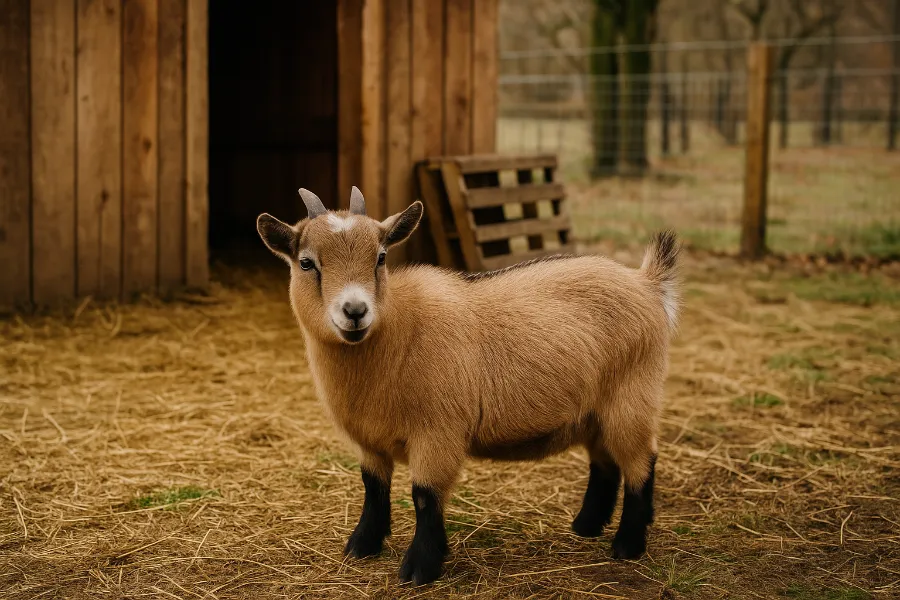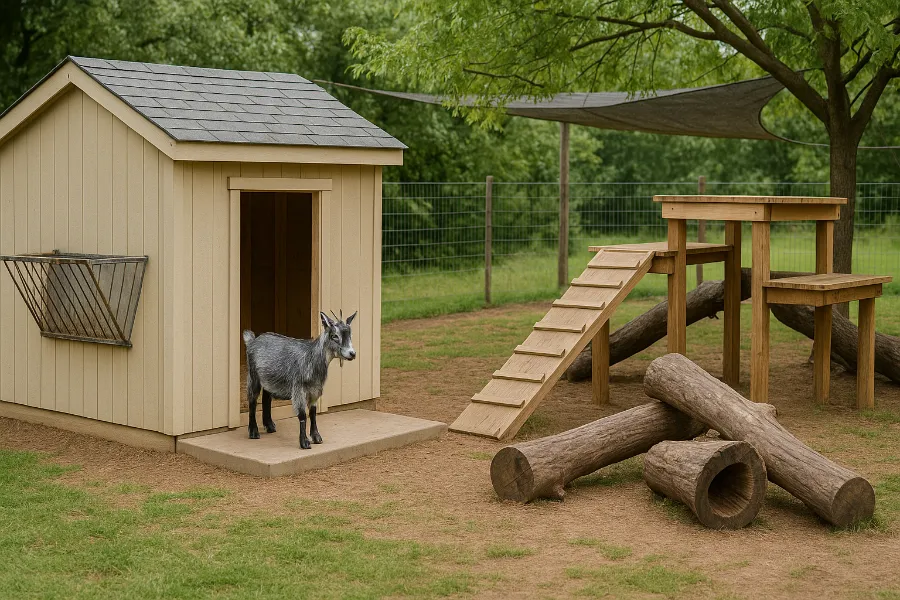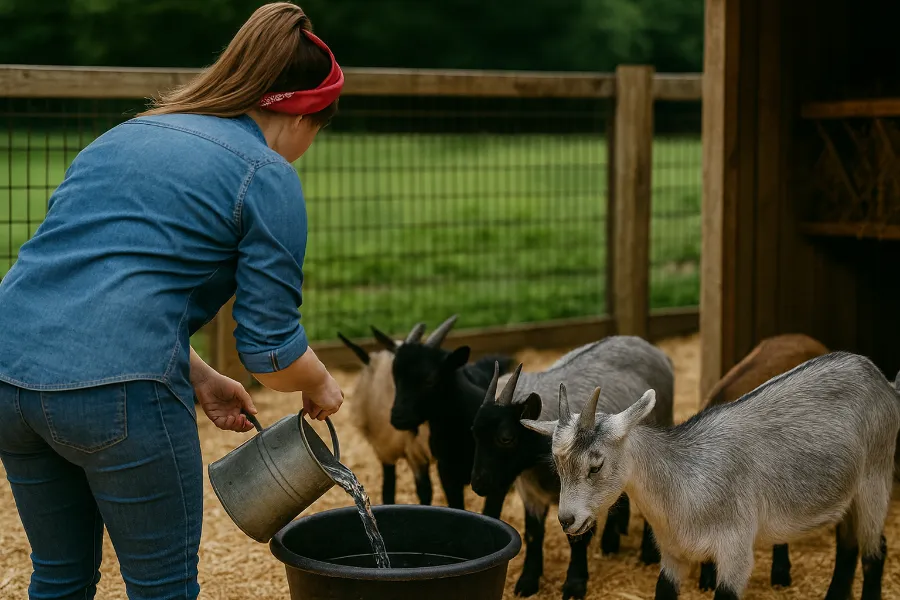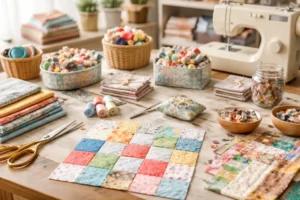I still remember the first time I met a pygmy goat. Tiny hooves clicking across the barn floor, bright eyes sizing me up and then that bold leap up onto a barrel, as if to say, “Here I am!” From that moment, I was hooked.
If you’re reading this, you’ve likely felt the same pull. Pygmy goats make wonderful companions: affectionate, lively, and full of personality. They’re not just “cute livestock” they can truly feel like pets. In this post, I’ll share everything I’ve learned (sometimes via trial and error) about raising pygmy goats, with the real talk you wish someone handed you up front.
Pygmy Goats as Pets

Yes, pygmy goats can absolutely be pets. When you bring them into your life, you’re signing up for more than hay and fence posts—you’re choosing companions with charm and character.
The Upside
- They’re social creatures. They’ll follow you, greet you, and even call when you’re late with dinner.
- They bring unexpected joy. A tiny goat kid stumbling through grass is one of those simple pleasures you’ll never forget.
- They can be useful. Goats help clear brush and manage weeds in pastures.
The Trade-Offs
- They talk. At odd hours, too.
- They test your fence daily (sometimes hourly).
- Zoning laws might not love goats in your neighborhood—always check local regulations first.
So yes—they are pets. But they retain that livestock side, so you need to walk both paths.
Goats as Pets
When people ask me if goats make good pets, my answer is: “It depends on what you expect from them.” They’re not like cats or dogs, but they do bond with people.
Why goats as pets work for some:
- They love attention.
- They can be affectionate.
- They’re endlessly entertaining.
Why they might not work for others:
- They require more space than typical house pets.
- They’re mischievous and sometimes destructive.
- They can be noisy and stubborn.
If you’re prepared for both the joys and the chaos, goats as pets can bring you years of laughter.
Goat Shelter

If there’s one thing you can’t skimp on, it’s goat shelter. When I first brought home my pair of pygmy goats, I tried using a converted dog kennel. Big mistake. Within months, I upgraded to a more robust structure and my goats thanked me by looking healthier, happier, and more relaxed.
What Your Goat Shelter Needs
- At least 15–20 square feet per goat inside.
- A dry, well-ventilated space. Goats dislike dampness more than you’d think.
- A roof that keeps out the rain, and walls or windbreaks to shield them from drafts.
- Elevated areas or platforms inside so they can perch and feel safe.
My Lessons Learned
- Use straw or shavings—but pack them deep in winter to insulate against cold floors.
- Make it easy to clean. If your shelter is a chore to maintain, you’ll let it slide and that’s when health issues show up.
- Consider a three-sided “run-in” for mild climates. Let them move in or out as they choose.
Goat Food
Let’s talk about the fuel that keeps those tiny bodies bounding: goat food. One of the trickiest parts of raising pygmy goats is balancing their diet so they’re healthy not overweight.
What They Eat
- Hay / Forage: This should be the bulk of their diet. Good grass hay is ideal.
- Grain: Use sparingly—typically for pregnant or nursing does or growing kids.
- Browse: Goats love leaves, twigs, shrubs—let them taste nature (within safe limits).
Supplements & Safety
- Mineral mix: Loose goat minerals (not just salt blocks) kept available free-choice.
- Water: Fresh, clean water is nonnegotiable.
- Avoid hazards: Never feed large amounts of alfalfa or high-calcium diets to bucks—you risk urinary calculi.
In my early days, I misjudged how much grain “a little” is. My goat looked plump, but not healthy. Trimmed back, she regained her energy and looked better than ever. Less is often more.
Goat Fencing
I kind of wish I had a dollar for every moment my goats tested the fence. Goat fencing is where your patience, planning, and sturdiness pay off.
What Worked for Me
- Woven wire with small openings: prevents heads from squeezing through.
- Electric lines: they create a mental barrier—goats learn fast to respect them.
- Avoid wide field fencing: the holes are often just big enough for a head to get stuck.
- Gates with strong latches. If a goat can flick it open, it will.
Practical Tips
- Keep at least 4 ft height—some goats are surprisingly good jumpers.
- Reinforce the bottom: goats push.
- Add interior play structures to distract them from testing your fence all day.
Goat Housing
“Goat housing” isn’t just the shelter—it’s the entire ecosystem they live in: shelter, yard, play areas, feeder layout.
Designing Your Goat Home
- Zone your space: sleeping inside, feeding in a clean area, roaming outside.
- Multi-level features: platforms, ramps, logs. Pygmy goats adore climbing and exploring.
- Feeding zones: raised hay racks so they don’t trample or contaminate food.
- Shade and cover: shade cloth or small trees help in hot weather.
When I first got mine, I underestimated the play structures. Now I can’t imagine goats without climbing opportunities—they stay out of trouble.
Goat Care
This is where the rubber meets the road. Goat care is a daily, weekly, and seasonal commitment.
Daily Routine
- Refill water and feed.
- Walk through the pen—check for injuries, limp legs, or weird behaviors.
- Clean bedding or pick droppings.
Weekly / Monthly
- Hoof trimming: Every 4–6 weeks.
- Parasite checks: Watch for anemia or changes in coat.
- Vaccinations: CDT is standard for goats.
Yearly & Seasonal
- Deep clean shelters.
- Rest or rotate pastures to reduce parasite load.
- Winter prep: extra bedding, windbreaks, and sometimes a light.
One mistake I made early on: ignoring hoof issues until they became serious. Now I trim regularly—no more limping goats in the morning.
Raising Pygmy Goats
“Raising pygmy goats” is a journey. From your first introductions to daily routines and future plans, you grow as they grow. Below are the lessons I wish someone told me when I started.
Start with Companionship
Never get just one. Pygmy goats are herd animals. Without a buddy, they get lonely and stressed.
Socializing & Trust
Spend time daily—talk to them, pet them, feed them by hand. The more interaction, the more bonded they’ll be.
Goat-Proof Everything
They’ll chew fence posts, test gates, climb the unknown. Give them room to explore—but don’t give them the keys.
Pasture Rotation
Rotate pastures to help break parasite cycles. When they graze the same spot constantly, worm eggs build up.
Plan for the Long Haul
Pygmy goats can live 10–15 years (or more). Don’t treat them as a short-term project—they become part of the family.

Wrapping Up
If you’ve read this far, you understand what I mean when I say pygmy goats are so much more than barn animals. They’re quirky roommates, garden helpers, and daily joy-bringers.
From thoughtful goat shelter and smart goat food decisions, to solid goat fencing, well-designed goat housing, consistent goat care, and the bigger picture of raising pygmy goats—you’re building a life alongside these wonderful creatures.
Pygmy goats are resilient, clever, and affectionate once they trust you. Invest in them, and they’ll repay you with laughter, companionship, and yes—even a little chaos now and then.
FAQs
Yes, pygmy goats make excellent pets because of their friendly and playful nature. They bond well with humans and thrive in pairs.
Each pygmy goat needs at least 200–400 square feet of outdoor space plus shelter. They also love climbing structures and room to play.
Pygmy goats mainly eat grass hay, browse, and small amounts of grain. They also need free-choice goat minerals and fresh water daily.
Yes, they need a dry, draft-free shelter with at least 15–20 square feet per goat. Proper ventilation and bedding help keep them healthy.
Strong goat fencing at least 4 feet tall is essential. Woven wire or livestock panels with secure gates work best.
With good care, pygmy goats typically live 10–15 years. Proper diet, shelter, and vet care extend their lifespan.
They require daily feeding, fresh water, and regular hoof trimming. Vaccinations and parasite checks are also part of good goat care.













